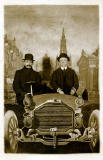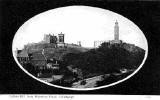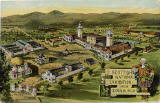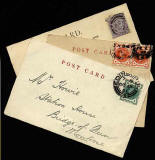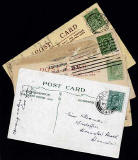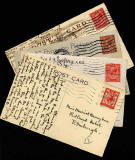|
Postcard History Portrait Postcards and Landscape Postcards |
|
On this site I have included examples of old post-cards. I still have a lot more details and images to add to this site. If you have any particular questions or requests, please email me. I may be able to help. I have grouped the cards into two sections: |
|
Portraits These were produced by many of Edinburgh's studios in the early years of the 20th century. Most followed the tradition and style of earlier cartes de visite and cabinet prints. They probably produced very small numbers of each post cards which then found their way into family albums and collections. These post-cards had markings for the stamp and their backs were divided into two parts, to take the message and address - but in practice, they appear to have seldom been sent through the post. Some included interesting props and backgrounds in their cards. A few photographers such as Moffat and Russell produced post cards of ministers, professors and other eminent figures. These presumably sold in larger numbers but, again, I have rarely seen any that have been sent through the post. All the portrait post cards that I have seen are monochrome. |
|
Landscapes Many photographers and publishers have produced views of Edinburgh. Some like Valentine of Dundee or GW Wilson of Aberdeen produced very large numbers of cards, covering scenes throughout Britain and elsewhere. However, many of Edinburgh's photographers appear to have produced cards concentrating on views of Edinburgh, or in some cases on their own area of the City. Many of the landscape post cards are in colour. |
|
Types and Dates of Postcards |
|||
|
1870 - Britain's first Postcards Postcards have been used in Britain since they were first introduced by the Post Office in 1870. These cards were plain cards issued by the Post Office. They had a pre-printed stamp. The address was written on one side of the card and the message, often very brief, was written on the other side. There was no picture. Here is an example form 1890, in which one Edinburgh photographer is advising another of the date of a photographic society meeting: |
|||
|
1894 - Britain's first Picture Postcards From 1 September 1894, the Post Office allowed postcards published by others to be posted. A halfpenny adhesive stamp was to be added to these cards before posting. Several manufacturers produced cards. The first publisher to include pictures to the cards is believed to have been George Stewart of 92 George Street, Edinburgh. |
|||
|
1895 - Court Cards From 1895 onwards, a size of 4.75 ins x 3.5 ins was adopted for postcards. These were known as Court Cards. The address was written on one side. The reverse bore a small picture leaving sufficient space to write a message. |
|||
|
1899 - Standard size of Postcard From 1899 onwards, the standard size of 5.5ins ins x 3.5 ins, already in use in other countries, was accepted in Britain. The address,, and nothing else, still had to be written on one side of the card. The other side being for the picture and message. In many cases the picture covered most of the card, leaving little room for the message. |
|||
|
1902 - Divided Backs In 1902 the Post Office changed its rules and allowed: - pictures to appear on the front of postcards - message and address both to appear on the back. The message was to be written on the left-hand side of the back and the address on the right-hand side of the back. Great Britain was the first country to allow this practice. From around September 1902 onwards, postcard manufacturers began to issue cards with a line drawn down the middle of the back to show where the message and address should be written. These cards soon replaced the earlier ones with 'undivided backs'. |
|||
|
1926 - Postcard Sizes In 1926 the Post Office specified the sizes of postcard that were allowed: - Min size: 4 ins x 2.75 ins. - Max size 5.875 ins x 4.125 ins. Postcards larger than the sizes above became more common later in 20th century, but they were not unknown early in the 20th century. I have tow examples of Valentine Series - Giant Postcards. Both are views of Edinburgh, measuring 7.5ins x 5.5ins. Both were posted in Edinburgh on 22 April 1910 (with a 1d stamp on each). |
|||
|
Postage
Rates If the cards have been posted, the postmark date can establish the latest possible date that a postcard was produced - sometimes the date is not legible, so the stamps used can be a guide Postage rates were sometimes printed on the backs of early UK postcards. These can help to determine the date of publication. The normal postage rates for postcards are given below: - ½d until 1918 There was no change in the 1/2d postage rate for inland postage for almost 50 years. (The overseas postage rate, at least in 1901, appears to have been 1d.)
- 1d from 3 June 1918
- 1½d
from 13 January 1921
- 1d from 24 May 1922 However, in some cases many years, or even decades, passed from the time that a photograph for a card was taken or the time that a postcard was first published to the time of posting. |
|||
|
Postage Rates Please click one of the images below to see examples of stamps on postcards.
|
|||
| With acknowledgement to reference books, including The Dictionary of Picture Postcards in Britain - 1894-1939 (by A W Coysh) for providing some of the dates above. |
|
Postcard Advert Here is a postcard advertising photographic material, including "sensitized postcards of all kinds". Please click here to enlarge the card. |
|
Dating Postcards bearing AZO stamp boxes Please click here to discover how to date postcards produced on Kodak photographic paper bearing AZO stamp boxes. |
|
Postcard Views |
|
PUBLISHERS: A B C D E F G H I J K L M N O P Q R S T U V W XYZ ? |
|
THUMBNAILS: A B C D E F G H I J K L M N O P Q R S T U V W XYZ ? |
|
Index |
|
FULL INDEX: Portraits, History, Stamps, Messages on Postcards, Postcards of Scotland, etc. |

